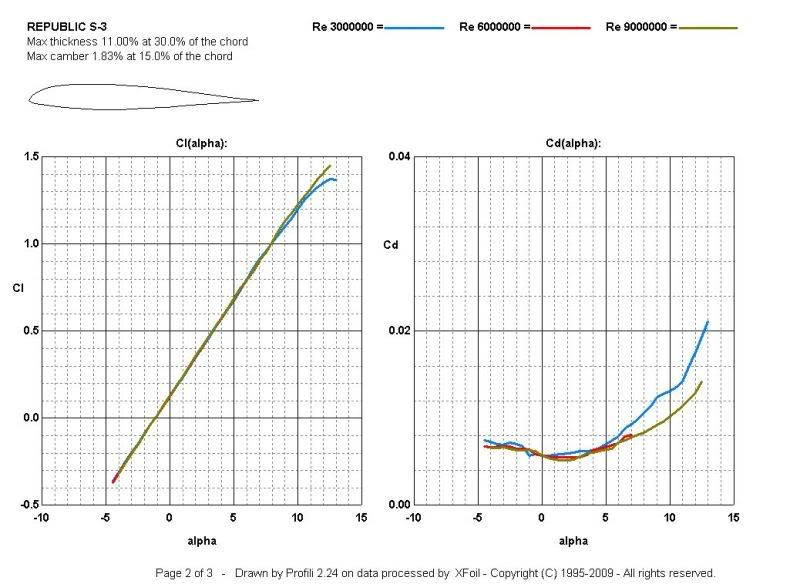
 |
|
|||||||
| IL-2 Sturmovik The famous combat flight simulator. |
 |
|
|
Thread Tools | Display Modes |
|
|
|
#1
|
|||
|
|||
|
What JtD said....
As for software, for many years a small program called X-Foil, done by the guys at MIT, has been a weapon of choice for simulating basic characteristics of any airfoil you wanted. It was created however, in the era when youngsters actually had a computer knowledge going above pushing an "on" button on their Playstation (early 2000, UNIX, communication through DOS console with no fancy UI whatsoever!), therefore today it might be considered "a bit" unfriendly... There is an Italian fella though, who created a small program called "Profili", which has an X-Foil module built-in and also has a nice'n easy Windows-style interface. Demo version is available for free, getting all functions requires some small donation though. Below you'll find a few polars it calculated for Republic S-3 airfoil, at standard "reasonable" Re numbers (Cl(alpha): only linear range!). As you can see, they look smoother then the versions found by you. Remember though, that even these are the result of numerical simulation and therefore, far from perfect - NOTHING beats the empirical test results from the wind tunnel! Cheers. 
Last edited by Art-J; 03-17-2011 at 07:11 PM. |
|
#2
|
||||
|
||||
|
Interesting. I'll have to check into that. I have found a copy of the NACA Report 824, and will dig into that after I finish In Pursuit.
I'm just curious about it. I was thinking about how every Seversky/Republic aircraft I know of, from the initial debut up to the jet age used an elliptical wing with the S-3 airfoil, from their 230mph amphibian, to the 470 mph P-47M. And while nearly every other fighter that was re-winged with one of the new laminar flow airfoils saw major performance improvements, the P-47 didn't, and was still just as fast as every other prop-job in the air. This begs the question, why? Is there something particular about the S-3 airfoil that makes it competitive with the laminar flow airfoils, that other widely used airfoils lacked? If so, why wasn't it more widely used: design ownership, a significant trade off, a different set of design priorities, something else? Was it just a quick of the Seversky designs that laminar flow didn't do much? And of course, while trying to dig up stuff on the S-3, I also discovered that the FW-190, F4F, F6F, and F4U all share the same airfoil, and have radically different handling behaviours. And then there's the Clark YH, and the NACA 2219, so as you can see, my questions are multiplying without end. Addendum: Command Prompt does not scare me, I've been using DOS since before I could read! Though I will admit, some of the tutorials on .bat scripting get a bit ominous. And now we set up the logger to load without being visible to the user! Last edited by Voyager; 03-18-2011 at 05:37 AM. |
|
#3
|
|||
|
|||
|
Trapezoidal wings generate far less drag compared to straight wings and elliptic shape is basically the perfect trapezoidal design.
Why wasn't it used in much more broader scale for it's superiority? Answer lies in production - elliptic shape was and is much more complicated and expensive to produce. I guess this could also be the reason for the airfoil to keep it's shape over the years - maybe they used the same production lines throughout the war? |
|
#4
|
|||
|
|||
|
I think the usage of the S3 is based on purely pragmatic reasons - Seversky used this airfoil for ages, had lots of experience with it, tools to built it and more of that. Other manufacturers didn't. Same way others used the (similar) 23000 series, had experience with it, tools to manufacture. It wasn't worth the change for Seversky.
Laminar flow wings weren't really a WW2 thing, they were more of a post WW2 thing. How many successful designs with S3 airfoil did Republic do after 45? While I don't know, I don't think it were many, were it? |
|
#5
|
||||
|
||||
|
The P-51, Tempest, and P-63 were all mid-war laminar flow designs. One of the P-47B's was fitted with a laminar flow wing in early 1942, but it did not show any performance improvement over the S-3 airfoil, so it wasn't just a matter of tooling or cost.
Tapered and elliptical wings have other drawbacks beyond cost. Because the lift drops as you get to the end of the wing, it tends to stall there first, robbing you of aileron control. |
|
#6
|
|||
|
|||
|
There's a difference between having a wing with a laminar flow design and having laminar flow over the wing. Surface quality in WW2 for the most part was not good enough to allow laminar flow airfoils to develop laminar flow to a larger extend than conventional airfoils do.
There's also a difference between building one prototype and building 15000 planes. |
|
#7
|
||||
|
||||
|
While generally productivity would be a major consideration, the Spiteful added 20-40mph to the top speed of the Spitfire, but wasn't produced after all, in the case of the XP-47F I more curious as to why it lost 7-10mph with the laminar wing installed, given that that was pretty much the opposite of what happened to every other design that had a laminar wing tested on it.
That's what I'm really wondering. |
 |
| Thread Tools | |
| Display Modes | |
|
|